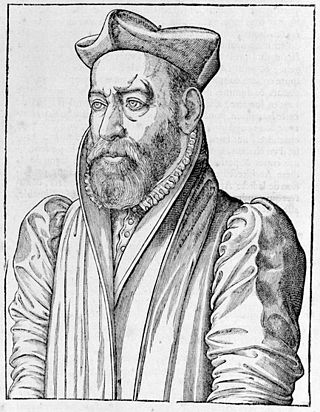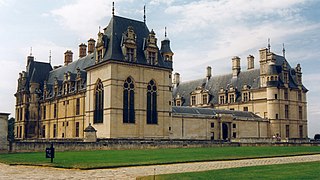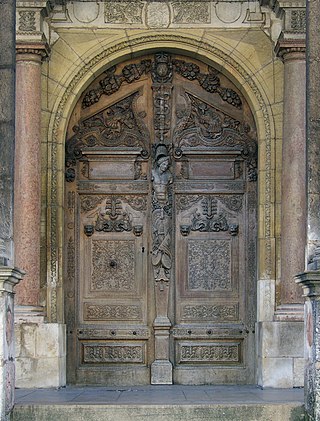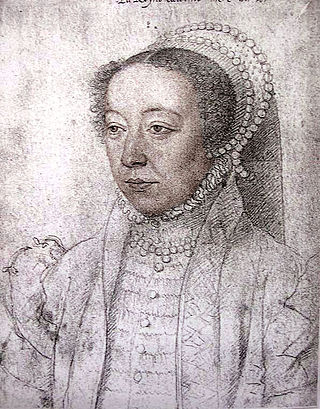
Mannerism is a style in European art that emerged in the later years of the Italian High Renaissance around 1520, spreading by about 1530 and lasting until about the end of the 16th century in Italy, when the Baroque style largely replaced it. Northern Mannerism continued into the early 17th century.

Palace of Fontainebleau or Château de Fontainebleau, located 55 kilometers southeast of the center of Paris, in the commune of Fontainebleau, is one of the largest French royal châteaux. The medieval castle and subsequent palace served as a residence for the French monarchs from Louis VII to Napoleon III. Francis I and Napoleon were the monarchs who had the most influence on the palace as it stands today. It became a national museum in 1927 and was designated a UNESCO World Heritage Site in 1981 for its unique architecture and historical importance.

Philibert de l'Orme was a French architect and writer, and one of the great masters of French Renaissance architecture. His surname is also written De l'Orme, de L'Orme, or Delorme.

The Tuileries Palace was a royal and imperial palace in Paris which stood on the right bank of the River Seine, directly in front of the Louvre. It was the usual Parisian residence of most French monarchs, from Henry IV to Napoleon III, until it was burned by the Paris Commune in 1871.
The School of Fontainbleau refers to two periods of artistic production in France during the late Renaissance centered on the royal Palace of Fontainebleau that were crucial in forming the Northern Mannerism.

Pierre Lescot was a French architect active during the French Renaissance. His most notable works include the Fontaine des Innocents and the Lescot wing of the Louvre in Paris. He played an important role in the introduction of elements of classical architecture into French architecture.

The French Renaissance was the cultural and artistic movement in France between the 15th and early 17th centuries. The period is associated with the pan-European Renaissance, a word first used by the French historian Jules Michelet to define the artistic and cultural "rebirth" of Europe.

Jean Bullant was a French architect and sculptor who built the tombs of Anne de Montmorency, Grand Connétable of France, Henri II, and Catherine de' Medici. He also worked on the Tuileries, the Louvre, and the Château d'Écouen. Bullant was a Huguenot.

Jean Goujon was a French Renaissance sculptor and architect.

French Renaissance architecture is a style which was prominent between the late 15th and early 17th centuries in the Kingdom of France. It succeeded French Gothic architecture. The style was originally imported from Italy after the Hundred Years' War by the French kings Charles VII, Louis XI, Charles VIII, Louis XII and François I. Several notable royal châteaux in this style were built in the Loire Valley, notably the Château de Montsoreau, the Château de Langeais, the Château d'Amboise, the Château de Blois, the Château de Gaillon and the Château de Chambord, as well as, closer to Paris, the Château de Fontainebleau.

André Le Nôtre, originally rendered as André Le Nostre, was a French landscape architect and the principal gardener of King Louis XIV of France. He was the landscape architect who designed the gardens of the Palace of Versailles; his work represents the height of the French formal garden style, or jardin à la française.

The Château d'Écouen is an historic château in the commune of Écouen, some 20 km north of Paris, France, and a notable example of French Renaissance architecture. Since 1975, it has housed the collections of the Musée national de la Renaissance.

Hugues Sambin was a Franc-comtois sculptor, trained as a menuisier or wood-worker; as a designer of Mannerist ornaments, his published designs, such as Oevvre de la diversite des termes, dont on use en architecture, reduicts en ordres, Lyon, 1572, inspired luxury furnishings, such as dressoires, armoires and cabinets. Its preface was signed "Hugues Sambin, Architecteur en la ville de Dijon".

Catherine de' Medici's building projects included the Valois chapel at Saint-Denis, the Tuileries Palace, and the Hôtel de la Reine in Paris, and extensions to the château of Chenonceau, near Blois. Born in 1519 in Florence to an Italian father and a French mother, Catherine de' Medici was a daughter of both the Italian and the French Renaissance. She grew up in Florence and Rome under the wing of the Medici popes, Leo X and Clement VII. In 1533, at the age of fourteen, she left Italy and married Henry, the second son of Francis I and Queen Claude of France. On doing so, she entered the greatest Renaissance court in northern Europe.
Events from the year 1559 in art.

Gardens of the French Renaissance were initially inspired by the Italian Renaissance garden, which evolved later into the grander and more formal jardin à la française during the reign of Louis XIV, by the middle of the 17th century.

Northern Mannerism is the form of Mannerism found in the visual arts north of the Alps in the 16th and early 17th centuries. Styles largely derived from Italian Mannerism were found in the Netherlands and elsewhere from around the mid-century, especially Mannerist ornament in architecture; this article concentrates on those times and places where Northern Mannerism generated its most original and distinctive work.

Jacques I Androuet du Cerceau, also given as Du Cerceau, DuCerceau, or Ducerceau (1510–1584) was a well-known French designer of architecture, ornament, furniture, metalwork and other decorative designs during the 16th century, and the founder of the Androuet du Cerceau family. He introduced Renaissance architecture to France with the assistance of Pierre Lescot, Philibert Delorme and Jean Bullant. Though he was referred to by contemporaries as architecte and was even appointed architecte du roi, he is remembered especially for his suites of engravings produced from 1549 from his printshop in Orléans.

The architecture of Paris and its nearest surrounding suburbs in the era of absolutism went through several important historical stages: the transition from Flamboyant to the Renaissance, the emergence of the "Jesuit style" and mannerism, the birth of Baroque and Classicism, the rise of the decorative Rococo style. The Italian Wars had a great influence on Parisian architecture and urban planning, during which the court of Louis XII became acquainted with the ideas of the Italian Renaissance.



















